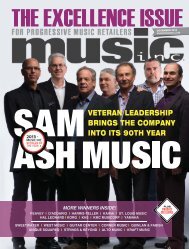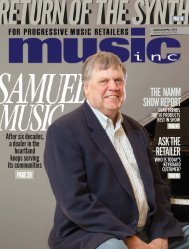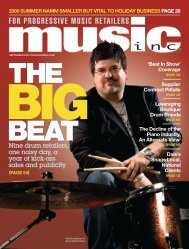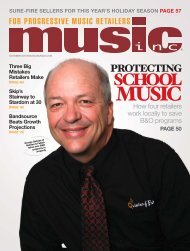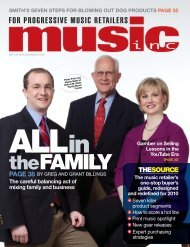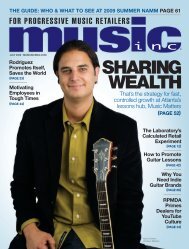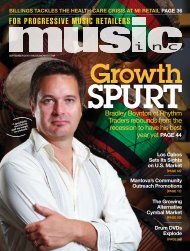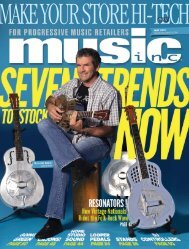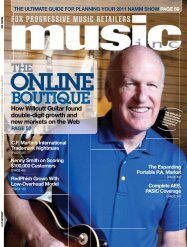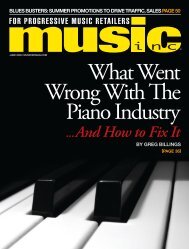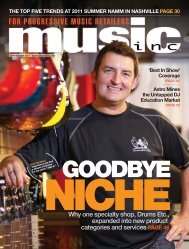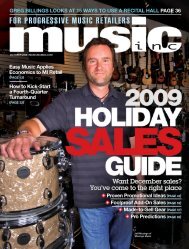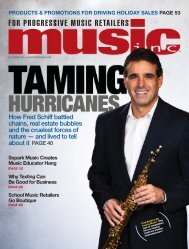VISIONARY - Music Inc. Magazine
VISIONARY - Music Inc. Magazine
VISIONARY - Music Inc. Magazine
You also want an ePaper? Increase the reach of your titles
YUMPU automatically turns print PDFs into web optimized ePapers that Google loves.
Not Your Dad’s Guitar Method<br />
To create a bona fide<br />
children’s guitar method,<br />
Jeff Schroedl had<br />
to forget everything<br />
he knew.<br />
“When you watch your own<br />
kids trying to play an instrument<br />
at that age, you learn a lot<br />
yourself,” said Schroedl, Hal<br />
Leonard’s vice president of pop<br />
and standard publications. “It<br />
showed me that creating a good<br />
method for kids isn’t as simple<br />
as adapting an existing method.<br />
It really requires a fresh start and<br />
an all-new approach.”<br />
That approach spawned Hal<br />
Leonard’s Guitar For Kids, written<br />
by Schroedl and Bob Morris,<br />
former director of education<br />
for Fender. Since its launch two<br />
years ago, the book has become<br />
one of Hal Leonard’s top-selling<br />
guitar methods and was followed<br />
up with Bass For Kids, Guitar<br />
For Kids Songbook, and a pack<br />
that combines the guitar method<br />
and songbook. This summer, Hal<br />
Leonard’s taking the lineup to the<br />
next level, launching children’s<br />
ukulele and drum methods. And<br />
according to Schroedl, there are<br />
more titles in the works.<br />
“We haven’t done clinics or<br />
workshops for this method at<br />
all, which is an important point,<br />
considering that it’s taken off,”<br />
he said. “Piano students have<br />
always started at an earlier age,<br />
but with guitar, it’s typically been<br />
9 or 10 years old. I think that’s<br />
been [decreasing], and this is one<br />
of the first methods to really address<br />
that. You can effectively<br />
start your son or daughter on<br />
the guitar at age 6.”<br />
SIMPLIFIED LEARNING<br />
Open Guitar For Kids, and<br />
you’ll immediately notice<br />
several differences from a typi-<br />
‘Creating a<br />
good method<br />
for kids isn’t<br />
as simple<br />
as adapting<br />
an existing<br />
method. It<br />
really requires<br />
a fresh start<br />
and an all-new<br />
approach.’<br />
— Jeff Schroedl<br />
cal method — larger chord symbols,<br />
simpler page designs and a<br />
slower-paced approach to learning.<br />
“For kids that young, the<br />
pages can’t look intimidating,”<br />
Schroedl said. “They have to be<br />
easy on the eyes.”<br />
The book starts by teaching<br />
one-finger chords, a C and a G7,<br />
Jeff Schroedl<br />
that only use the top three guitar<br />
strings. From there, kids learn a<br />
song, Harry Nilsson’s “Coconut,”<br />
strumming G7 in quarter notes.<br />
Next up is “Yellow Submarine,”<br />
“The Hokey Pokey,” and with the<br />
introduction of the Em chord,<br />
“Get Up, Stand Up” and “Eleanor<br />
Rigby.” (Hal Leonard’s generous<br />
copyright library fleshed out the<br />
method with a wealth of popular<br />
tunes.) An accompanying CD<br />
also features more than 30 playalong<br />
tracks.<br />
“We’ve identified a number of<br />
one-chord songs and two-chord<br />
songs, and there aren’t many,”<br />
Schroedl said with a laugh.<br />
By the end of the book, kids<br />
are introduced to G, D and A<br />
chords, as well as notes on the<br />
first three strings.<br />
“A traditional method is<br />
much faster-paced and starts<br />
with typically playing three notes<br />
on the first string and three notes<br />
on the second string,” Schroedl<br />
said. “And it often introduces<br />
two or three chords at a time —<br />
full, open chords. This guitar<br />
method begins with one-finger<br />
chords.”<br />
TEACH YOUR CHILDREN WELL<br />
The method’s simplicity isn’t<br />
only designed to appeal to<br />
kids. Schroedl pointed out that,<br />
given the economic climate, a lot<br />
of parents are forgoing paid music<br />
lessons and teaching their kids<br />
at home. Guitar For Kids’ back<br />
cover copy even encourages such<br />
home-schooling.<br />
“Obviously, it’s better to have<br />
a professional guitar teacher<br />
— don’t get me wrong — but<br />
it’s very possible for a parent,<br />
especially a parent with some<br />
musical background, to teach<br />
their own kids,” Schroedl said.<br />
To aid parents, the methods include<br />
melody cues at the bottom<br />
of each page.<br />
Not that Hal’s cutting music<br />
retailers out of the mix. Schroedl<br />
said he sees opportunity in crossmerchandising<br />
the books next<br />
to three-quarter-size axes and<br />
adding them onto entry-level<br />
guitar sales. And several dealers<br />
have already incorporated the<br />
books into their lesson programs,<br />
including Eric Lacovara, buyer<br />
at Berwyn, Pa.-based George’s<br />
<strong>Music</strong>, which uses the titles in<br />
its group and private teaching.<br />
“These books are laid out very<br />
well, and many of our teachers<br />
use the method book plus songbook<br />
with CD as supplemental<br />
material during their lessons,”<br />
he said.<br />
“The nice thing is, if they can<br />
get students started at a younger<br />
age and teach them, obviously,<br />
once they can play, they’re going<br />
to graduate to other books, other<br />
instruments and purchase other<br />
[items],” Schroedl said. “It gets<br />
them hooked at an early age.” MI<br />
JULY 2011 I MUSIC INC. I 39



